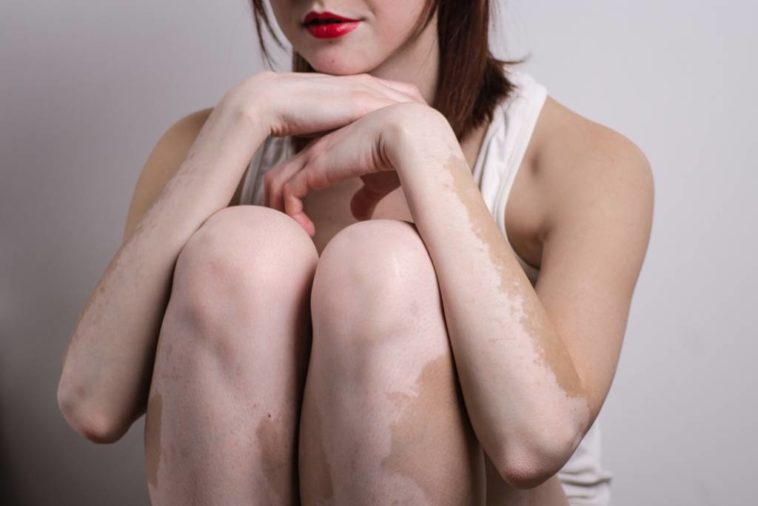Nonsegmental Vitiligo (NSV) is a chronic skin disorder that is the more common of the two types of vitiligo. It is characterized by progressive, depigmented lesions of the skin, mucosa, and hair. Just like Segmental Vitiligo (SV), NSV can appear at any age. However, many studies suggest that it is more likely to appear around the age of 20.
The total area of affected skin varies between individuals. However, it is always hard to predict whether the patches will spread, and by how much. The spread might take weeks, or remain stable for months or years. They can also affect the eyes, the inside of the mouth, and the hair. In most cases, the skin affected by Nonsegmental vitiligo remains depigmented for the rest of the person’s life. Since the condition is photosensitive, affected areas are more sensitive to sunlight than those that are not.
It is believed that Nonsegmental vitiligo is caused by an immunologically complex mechanism. It is often difficult to distinguish the onset of new NSV lesions from segmental vitiligo lesions developed on the skin.
Possible Causes
The NSV induced patches appear when melanocytes (the cells responsible for producing the skin pigment) within the skin die off. Why ongoing loss of melanocytes takes place is still unknown and the subject of various ongoing studies.
According to many experts, the leading role in the damage of melanocytes in vitiligo is played by autoimmune mechanisms. Hence, autoimmunity is the most widely accepted hypothesis to explain the pathogenesis of NSV. Oxidative stress is also currently considered to be one of the causes.
Researchers have been frequently associating NSV with other autoimmune diseases, (Hashimoto’s Thyroiditis and Graves’ disease, Rheumatoid Arthritis, Type 1 diabetes, Psoriasis, Pernicious Anemia, Systemic Lupus Erythematosus, Addison’s disease, and Alopecia Areata). In many research studies, family history, detection of associated disorders and side effects of previous therapy were reported in the non- segmental vitiligo group only. While the exact causes of NSV are unclear, a number of factors may contribute, including:
- A stressful event
- Harm to the skin due to a critical sunburn or cut
- Exposure to some chemicals
- A neural cause
- A virus
Treatment options
Since the exact cause of the vitiligo is not known, there is no effective treatment to cure Nonsegmental Vitiligo. New drugs targeting the immune response in combination with antioxidant agents may help some patients, while some may get benefitted by stress management practices. Some of the available treatment options include:
Phototherapy with UVB light: Exposure to ultraviolet B (UVB) lamps is emerging as common treatment option. While home treatment requires a small lamp for daily use, full-body treatment is done at a healthcare facility. Combined with other treatments, UVB phototherapy can have a positive effect on vitiligo. However, the result is not totally predictable.
Phototherapy with UVA light: UVA Phototherapy is usually conducted once the patient takes a drug that increases the skin’s sensitivity to UV light. Then, in a series of treatments, the affected skin is exposed to high doses of UVA light.
Steroid creams: At times, applying topical corticosteroids can stop the spread. Many people using them have even reported total restoration of the original skin color. A form of vitamin D, Calcipotriene can also be used as a topical ointment.
Medication: As per a 2013 research, Pseudocatalase may provide a cure for the loss of skin color in Nonsegmental Vitiligo. Some people might be low melanin levels due to lower levels of the α-melanocyte-stimulating hormone (alpha-MSH). Hence, usage of Afamelanotide can be effective. An arthritis drug – tofacitinib citrate – has also shown some promise.
Skin grafts: In this method, a surgeon removes healthy patches of the person’s pigmented skin and uses them to cover affected areas. This procedure is not very common.
Depigmenting: If the affected area covers 50 percent (or more) of the body, depigmentation therapy can be considered as an option. The method reduces the skin color (by applying strong topical lotions or ointments) in unaffected parts to match the depigmented areas. Though treatment is permanent, it can make the skin more fragile. Hence, long exposure to the sun is avoided.
Tattooing: Surgery is used to implant pigment into the skin. The procedure works best on the lips. Drawbacks can include difficulty matching the color of skin and the fact that tattoos ultimately fade out.
Skin camouflage: if the person has mild vitiligo, he/she can camouflage some of the patches with cosmetic creams and makeup. Most of such topical applications are waterproof.

